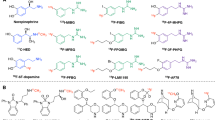Abstract
By virtue of its ideal nuclear physical characteristics for routine nuclear medicine diagnostics and its ready availability, technetium-99m is of outstanding interest in the development of novel radiopharmaceuticals. The potential for the development of 99mTc-based radioligands for the study the receptor function in the central nervous system (CNS) is also well recognised despite the difficulties to be overcome. A fundamental challenge is the pharmacologically acceptable integration of the transition metal technetium, with its specific coordination chemistry, into the molecular entity of CNS receptor ligands. Conceptually, the ligand molecule can be assembled by three building blocks: a small neutral chelate unit, an organic linker that may also serve as a pharmacological modifier and a receptor-binding region derived from selective receptor antagonists. The recent introduction of novel technetium chelate units, particularly mixed-ligand complexes and low-valency organometallic compounds of technetium, provides an impetus for the further development of CNS receptor ligands. Moreover, progress in receptor pharmacology and the experience gained with positron emission tomography radiotracers have facilitated the design of numerous 99mTc-based CNS receptor ligands. The formidable challenge of developing 99mTc probes as single-photon emission tomography imaging agents targeting CNS receptors can be viewed with optimism given the successful development of [99mTc]TRODAT-1 as a 99mTc complex for imaging dopamine transporters in the brain, although there are a number of receptor-specific imaging agents that have so far resisted all efforts to develop them. This review presents recent advances and discusses the remaining hurdles in the design of 99mTc-based CNS receptor imaging agents.
Similar content being viewed by others
Author information
Authors and Affiliations
Corresponding author
Additional information
Electronic Publication
Rights and permissions
About this article
Cite this article
Johannsen, B., Pietzsch, HJ. Development of technetium-99m-based CNS receptor ligands: have there been any advances?. Eur J Nucl Med 29, 263–275 (2002). https://doi.org/10.1007/s002590100652
Published:
Issue Date:
DOI: https://doi.org/10.1007/s002590100652




